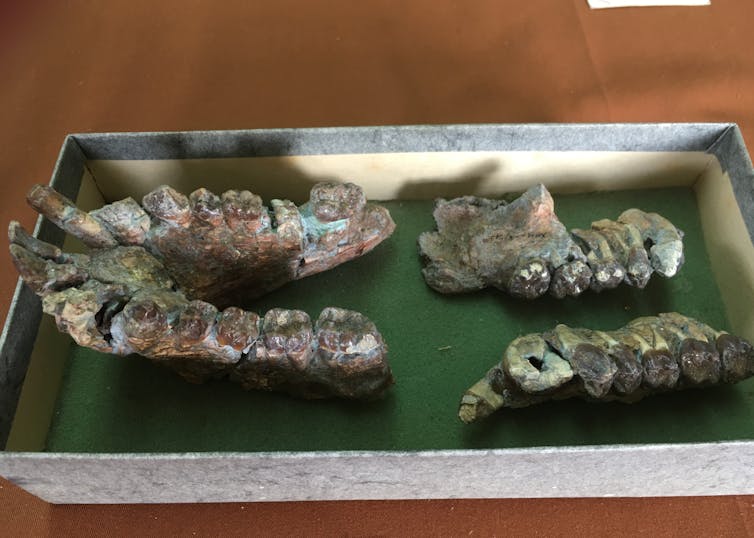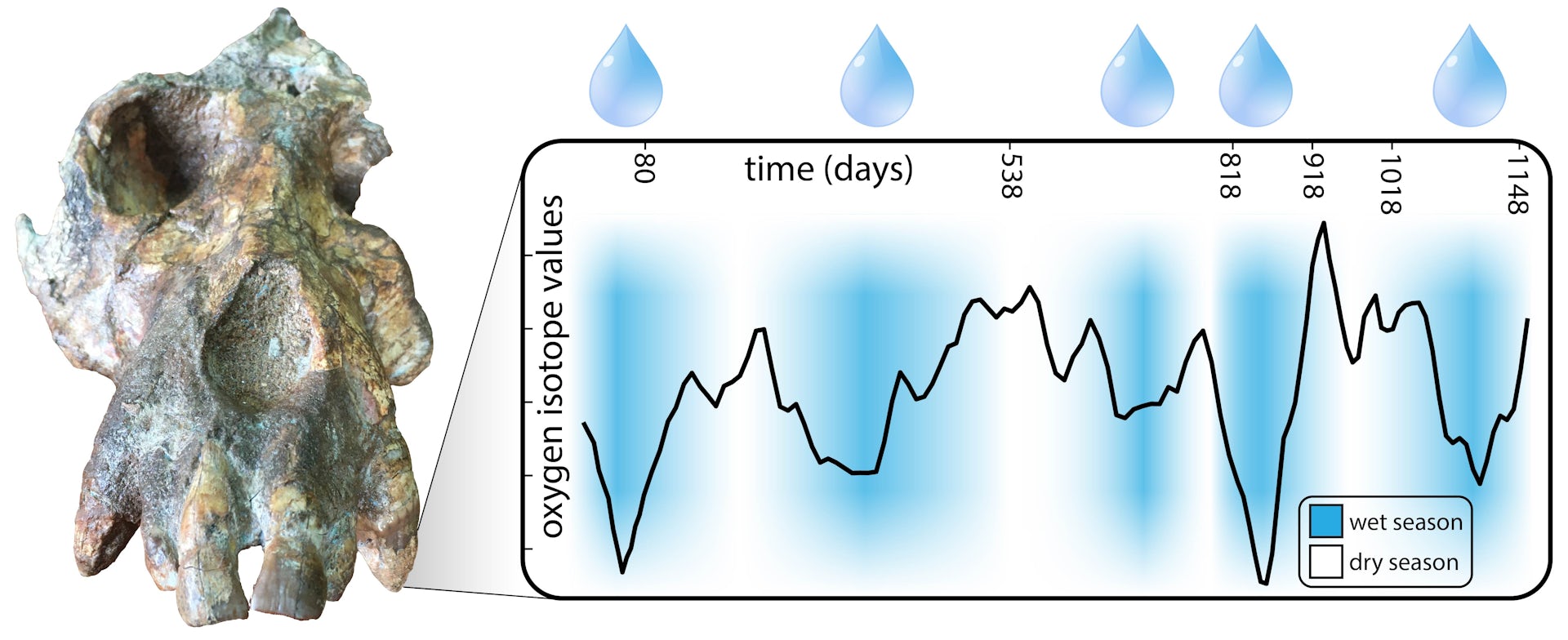The tactic depends on Creationists not realising that deductive logic and objective analysis of the evidence is a perfectly valid way to determine what happened. Ask a Creationist who is trying out that fallacy, how they can be certain their great grandparents had sex if they weren't there to witness it, and they usually withdraw from the conversation, often hurling abuse and threats as they do so. Of course, theirs, their parents and their grandparents existence are all evidence that their great grandparents got close at least ones.
That was a long-winded introduction to a piece of research published recently in PNAS that reports how an international collaboration of scientists have shown how fossil teeth of pre-human African apes can be analysed to determine the climate changes that may have driven theirs, and eventually our, evolution.
The account of how they did this and its significance is explained in an article in The Conversation by Tanya M. Smith, Professor in the Australian Research Centre for Human Evolution & Griffith Centre for Social and Cultural Research, Griffith University, Australia, and Daniel Green, a Postdoctoral Research Scientist at Lamont-Doherty Earth Observatory and Climate School, Columbia University, New York.
The article is reproduced here, reformatted for stylistic consistency, under a Creative Commons licence. The original article can be read here:

Revelations from 17‑million‑year‑old ape teeth could lead to new insights on early human evolution

Fossilised jaws from the 17 million-year-old Kenyan ape Afropithecus turkanensis.
Source: Tanya M. Smith/National Museums of Kenya, Author provided
The timing and intensity of the seasons shapes life all around us, including tool use by birds, the evolutionary diversification of giraffes, and the behaviour of our close primate relatives.
Some scientists suggest early humans and their ancestors also evolved due to rapid changes in their environment, but the physical evidence to test this idea has been elusive – until now.
After more than a decade of work, we’ve developed an approach that leverages tooth chemistry and growth to extract information about seasonal rainfall patterns from the jaws of living and fossil primates.
We share our findings in a collaborative study just published in Proceedings of the National Academy of Sciences.
Teeth are environmental time machines
During childhood our teeth grow in microscopic layers similar to the growth rings found in trees. Seasonal changes in the world around us, such as droughts and monsoons, influence our body chemistry. The evidence of such changes is recorded in our teeth.
That’s because the oxygen isotope composition of drinking water naturally varies with temperature and precipitation cycles. During warm or dry weather, surface waters accumulate more heavy isotopes of oxygen. During cool or wet periods, lighter isotopes become more common.
These temporal and climatic records remain locked inside fossilised tooth enamel, which can maintain chemical stability for millions of years. But the growth layers are generally so small that most chemical techniques can’t measure them.
To get around this problem, we teamed up with geochemist Ian Williams at the Australian National University, who runs the world-leading Sensitive High Resolution Ion Microprobe (SHRIMP) facilities.
We also analysed two fossil molars from an unusual large-bodied ape called Afropithecus turkanensis that lived in Kenya 17 million years ago. Diverse groups of apes inhabited Africa during this period, roughly 10 million years before the evolution of our early ancestors, the hominins.

Thin slice of a 17-million-year-old Afropithecus tooth illuminated with polarised light reveals progressive growth (right to left). We microsampled oxygen isotopes weekly for over three years, or 1148 days, in this tooth.
Credit: Tanya M. Smith
Several aspects of our research are helpful for understanding the link between environmental patterns and primate evolution.
First, we observe a direct relationship between historic African rainfall patterns and primate tooth chemistry. This is the first test of a highly influential idea in archaeological and earth sciences applied to wild primates: that teeth can record fine details of seasonal environmental change.
We are able to document annual west African rainy seasons and identify the end of east African droughts. In other words, we can “see” the storms and seasons that occur during an individual’s early life.
And this leads into another important aspect. We provide the largest record of primate oxygen isotope measurements collected so far, from diverse environments in Africa that may have resembled those of ancestral hominins.
Lastly, we’ve been able to reconstruct annual and semi-annual climate cycles, and marked environmental variation, from information held within the teeth of the two fossil apes.
Our observations support the hypothesis that Afropithecus developed certain features to adapt to a seasonal climate and challenging landscape. For example, it had specialised dental traits for hard object feeding, as well as a longer period of molar growth compared with earlier apes and monkeys – consistent with the idea that it consumed more seasonally varied foods.

Oxygen isotopes from the teeth of Afropithecus reveal wet and dry seasons that occurred 17 million years ago in eastern Africa.
Daniel R. Green & Tanya M. Smith
Previous studies of more than 100 fossil teeth have missed the most interesting part of oxygen isotope compositions in teeth: the huge seasonal variation on the landscape.
Read more:
What teeth can tell about the lives and environments of ancient humans and Neanderthals
Research potential closer to home
This novel research approach, coupled with our fossil ape findings and modern primate data, will be crucial for future studies of hominin evolution – especially in Kenya’s famous Turkana Basin.
For example, some researchers have suggested that seasonal differences in foraging and stone tool use helped hominins evolve and coexist in Africa. This idea has been hard to prove or disprove, in part because seasonal climatic processes have been hard to tease out of the fossil record.
Our approach could also be extended to animal remains from rural Australia to gain further insight into historic climate conditions, as well as the prehistoric environmental changes that shaped Australia’s unique modern landscapes.
Read more:
Archaeology can help us prepare for climates ahead – not just look back
SignificanceThe daft notion, invented by Ken Ham because of embarrassment over the massive difference between what the Bible says and what science is showing really happened, that there is a difference between 'historical' [sic] science and 'current' science, because the latter is based on observation whereas the latter is based on deduction is of course, nonsensical, as we would expect coming from that fraud's attempt to appeal to suckers with a child-like mind, as these sorts of experiments show.
Environmental variability may have spurred unique adaptations among Miocene apes and later hominins, but this hypothesis has been impossible to test on the scale relevant to individual lifespans. We establish that oxygen isotope compositions in modern primate teeth record annual and semiannual seasonal rainfall patterns across a broad range of environments in equatorial Africa. We then document annual dry seasons experienced by the large-bodied Early Miocene ape Afropithecus turkanensis, which may explain its novel dental adaptations and prolonged development. By revealing real-time historical and prehistoric environmental variation on a near weekly basis, we demonstrate that extraordinary behavioral and ecological variability can be recovered from modern and fossil African primates.
Abstract
Variability in resource availability is hypothesized to be a significant driver of primate adaptation and evolution, but most paleoclimate proxies cannot recover environmental seasonality on the scale of an individual lifespan. Oxygen isotope compositions (δ18O values) sampled at high spatial resolution in the dentitions of modern African primates (n = 2,352 near weekly measurements from 26 teeth) track concurrent seasonal precipitation, regional climatic patterns, discrete meteorological events, and niche partitioning. We leverage these data to contextualize the first δ18O values of two 17 Ma Afropithecus turkanensis individuals from Kalodirr, Kenya, from which we infer variably bimodal wet seasons, supported by rainfall reconstructions in a global Earth system model. Afropithecus’ δ18O fluctuations are intermediate in magnitude between those measured at high resolution in baboons (Papio spp.) living across a gradient of aridity and modern forest-dwelling chimpanzees (Pan troglodytes verus). This large-bodied Miocene ape consumed seasonally variable food and water sources enriched in 18O compared to contemporaneous terrestrial fauna (n = 66 fossil specimens). Reliance on fallback foods during documented dry seasons potentially contributed to novel dental features long considered adaptations to hard-object feeding. Developmentally informed microsampling recovers greater ecological complexity than conventional isotope sampling; the two Miocene apes (n = 248 near weekly measurements) evince as great a range of seasonal δ18O variation as more time-averaged bulk measurements from 101 eastern African Plio-Pleistocene hominins and 42 papionins spanning 4 million y. These results reveal unprecedented environmental histories in primate teeth and suggest a framework for evaluating climate change and primate paleoecology throughout the Cenozoic.
Green, Daniel R.; Ávila, Janaina N.; Cote, Susanne; Dirks, Wendy; Lee, Daeun; Poulsen, Christopher J.; Williams, Ian S.; Smith, Tanya M.
Fine-scaled climate variation in equatorial Africa revealed by modern and fossil primate teeth
Proceedings of the National Academy of Sciences (PNAS) 2022: 19(35); e2123366119; DOI: 10.1073/pnas.2123366119
Copyright: © 2022 The authors.
Published by PNAS. Open access
Reprinted under a Creative Commons Attribution 4.0 International license (CC BY 4.0)
Just as with forensic science it is possible using measurement and observation on historical data, to make valid deductions about what really happened.
Ham's tactic of teaching children to constantly ask, "Were you there?" is designed not to discover the truth but to disrupt the lecture or class to prevent it being explained.



No comments :
Post a Comment
Obscene, threatening or obnoxious messages, preaching, abuse and spam will be removed, as will anything by known Internet trolls and stalkers, by known sock-puppet accounts and anything not connected with the post,
A claim made without evidence can be dismissed without evidence. Remember: your opinion is not an established fact unless corroborated.